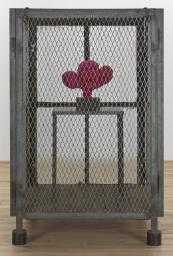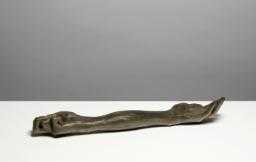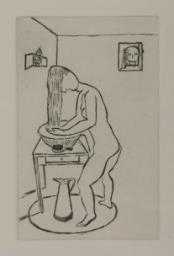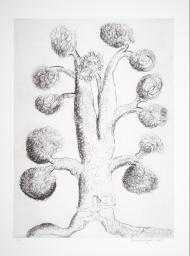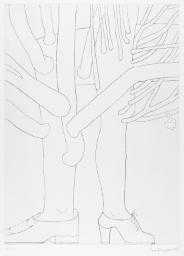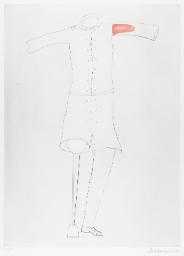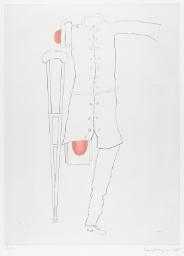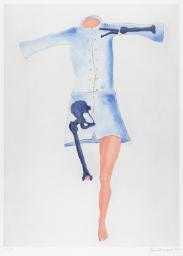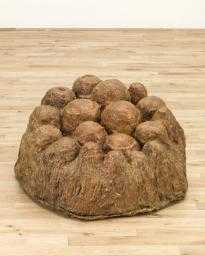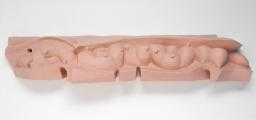
Not on display
- Artist
- Louise Bourgeois 1911–2010
- Medium
- Bronze, silver nitrate patina
- Dimensions
- Object: 152 × 254 × 178 mm
- Collection
- ARTIST ROOMS
Tate and National Galleries of Scotland. Lent by Artist Rooms Foundation 2011
On long term loan - Reference
- AL00228
Summary
This free-standing bronze sculpture consists of a tightly knotted coil of tubular forms, from the centre of which emerges a slender human hand cradling a recumbent female figure. The elongated shape of the curved fingers and thumb echo the sinuous tubular forms, which, along with the sculpture’s all-over silver patina, accentuates the flesh-like quality of the spiralling coil. The figure is positioned on her back in the palm of the hand with her head tilted upwards towards the tips of the fingers while her legs point back into the spiral. Her head, torso and legs are fully formed, but she has no arms. Her hair extends behind the fingers of the hand and rejoins the spiral, creating a cohesive, cyclical entity.
To create the hand, Bourgeois worked from a combination of casts and mouldings of hands and elongated the fingers. The sculpture is one of a number of works created between 1984 and 1986 that share the title Nature Study. Most of these works were cast in bronze with a black or silver patina, but some were made in rubber, plaster and wax and one of the works, which is compositionally identical to the bronze Nature Study was sculpted from pink marble.
The slender fingers suggest that the hand is that of a woman, while the gentle way in which the smaller undeveloped figure is cradled conveys a sense of maternal nurture. Indeed the way in which the hand appears to emerge from inside the coil, as though presenting the figure to the outside world, is evocative of birth, or perhaps re-birth, given the post-pubescent body of the figure. In this respect the work may represent the cyclical nature of motherhood and childbirth: the mother, represented by the hand, produces a daughter who will in turn become a mother herself. The title, Nature Study, also lends itself to this idea of a natural order or cycle of things, while the tight, spiral form, coiling from its source in the figure’s hair, is suggestive of the knotted and intertwined nature of familial relationships.
The spiral form is one that appears frequently in Bourgeois’s work, as in Spirals 2005 (Tate AL00346) and A l’infini 2008–9 (Museum of Modern Art, New York) where, again, the idea of an endless natural cycle is explored. In 1994 Bourgeois explained why spirals were personally significant for her:
The spiral is important to me. It is a twist. As a child, after washing tapestries in the river, I would turn and twist and ring them [...] Later I would dream of my father’s mistress. I would do it in my dreams by ringing her neck. The spiral – I love the spiral – represents control and freedom.
(Quoted in Gardner 1994, p.68.)
Another of Bourgeois’s works with the title Nature Study, also made in 1986, (Robert Miller Gallery) is a bronze sculpture with a black patina and features a coiled spiral wrapped tightly around a phallic object. Unlike the silver-patinated Nature Study, where the spiral brings forth a female figure in a productive, maternal gesture, the spiral here appears to constrict and squeeze the phallus, skewing its shape in an aggressive manner.
Hands and hand gestures also have symbolic significance in Bourgeois’s work. In her sculpture Give or Take 2002 (Tate AL00343), the hand is depicted as being either open or closed, and thus symbolic of either comfort and closeness, or coldness and rejection. In 10AM is When You Come to Me 2006 (Tate AL00345) the hand again appears as a symbol for human relationships, this time offering the consoling, nurturing grasp mirrored in Nature Study 1986.
Further reading
Paul Gardner, Louise Bourgeois, New York 1994.
Mignon Nixon, Fantastic Reality: Louise Bourgeois and a Story of Modern Art, Cambridge, Massachusetts 2005.
Lucy Askew and Anthony d’Offay, Louise Bourgeois: A Woman Without Secrets, exhibition catalogue, National Galleries of Scotland, Edinburgh 2013, p.38, reproduced pp.30, 39.
Allan Madden
The University of Edinburgh
November 2014
The University of Edinburgh is a research partner of ARTIST ROOMS.
Does this text contain inaccurate information or language that you feel we should improve or change? We would like to hear from you.
Explore
- abstraction(8,615)
-
- from recognisable sources(3,634)
-
- figure(2,270)
- hand(602)
- female(1,681)
- social comment(6,584)
-
- gender(1,689)
You might like
-
Louise Bourgeois Tits
1967 -
Louise Bourgeois Single II
1996 -
Louise Bourgeois Cell XIV (Portrait)
2000 -
Louise Bourgeois Give or Take
2002 -
Louise Bourgeois Spider
1994 -
Louise Bourgeois Toilette
1994 -
Louise Bourgeois Birth
1994 -
Louise Bourgeois Tree with Woman
1998 -
Louise Bourgeois Tree with Shoes
1998 -
Louise Bourgeois Amputee
1998 -
Louise Bourgeois Amputee with Peg Leg
1998 -
Louise Bourgeois Amputee with Crutch
1998 -
Louise Bourgeois Blue Dress
1998 -
Louise Bourgeois Avenza
1968–9, cast 1992 -
Louise Bourgeois Mamelles
1991, cast 2001



